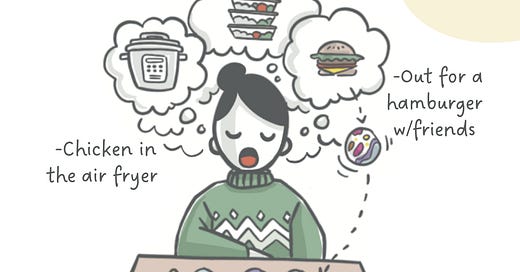When a person tells you the story of what happened and how they were thinking at the time, they don't tell a sequential, straight story. To tame this, researchers often write a linear set of interview questions to make sure they can report a simple, clear understanding back to their team.
These questions make an artificial relationship between interviewer and participant, where the participant waits for the interviewer to ask the next question, trying to follow the interviewer’s way of seeing the parts of the process being examined. They are in “session mode” all the time, instead of allowing the participant to explain from “memory mode.”
This works fine for orgs who make linear solutions for defined processes. But what about non-defined processes like cooking dinner?
You can embrace any tangle of topics without forcing it into a list of pre-defined questions. Here is how:
Each topic about cooking dinner last week is like a candy with many layers.
The listener does not bring up any topics. Only follow theirs.
One candy has many concepts in it, only related by the topic.
Each candy has layers. The outer layers are how we typically chat:
description: explanations, facts, scenes
expression: opinions, preferences, attitudes
generalizations, implied or future thinking
The core is how we understand a person’s mind:
inner thinking
emotional reactions
personal rules
This structure
simplifies your approach to an interview
gives the person a chance to tell their story their way
results in enough interior cognition that you can find patterns of cognition across people’s different stories
Why is this important? The patterns you find will burst open the borders your team and your org subconsciously put around your solutions, in terms of how you might support people. For the study about making dinner, the org made a big innovation in the kitchen.
Learn what questions to ask, what pull-tabs are, and how to make it easier for a person to tell you what happened in their mind. Choose either the book Time to Listen or the course Listening Deeply. (Two solutions to support a variety of thinking styles, yay! The course comes in a variety of price-levels, too!)








